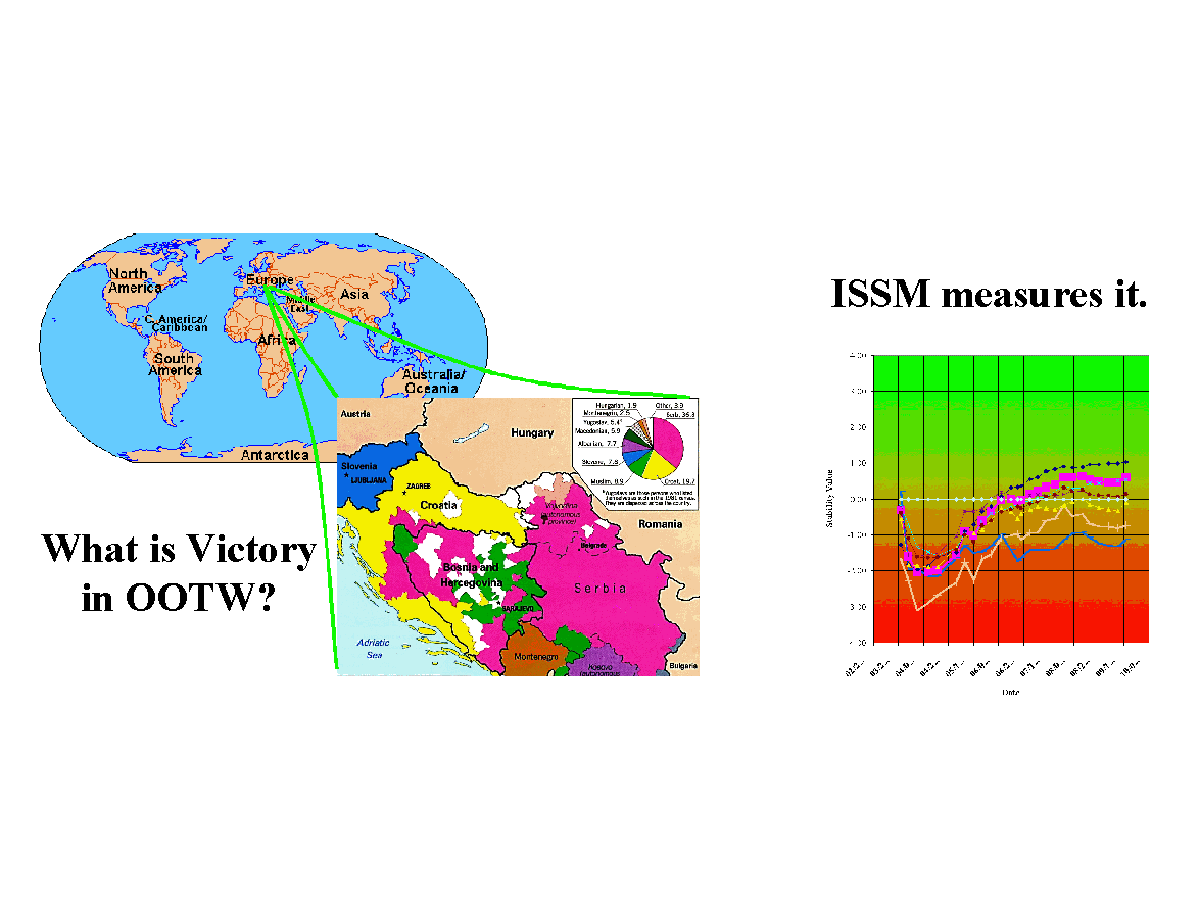 |
| Project Metadata | Keywords | |||||||||||||||||||||||||||||||||||||||||||||||||||||||||||||||||||||||||||||||||||||||||||||||||||
|
|
Create an easily operated tool to track stability and peacefulness in Operations Other Than War (OOTW). [Related terms are Low Intensity Conflict (LIC), Stability and Support Operations (SASO), Global War on Terror (GWOT), Stability, Security, Transition and Reconstruction (SSTR) operations, and Human Social Culture Behavior (HSCB).] The ISSM is a full scale Diplomatic, Information, Military, Economic (DIME) / Political, Military, Economic, Social, Infrastructure, Information (PMESII) tool.
 |
The Interim Static Stability Model (ISSM) was inspired by Hayes & Sands’, Doing Window: Non-Traditional Military Responses to Complex Emergencies (citation below). The ISSM is implemented as an Excel spreadsheet and describes impact on the "civil stability and durable peace" of values for a set of factors within a single country. It provides instantaneous impact but does not allow feedback loops or actions over time.
The principal output variable and the 30 input variables are listed below. The ISSM permits a scenario name input to customize its use. The date permits status tracking and plotting for up to 50 entries, with user-selected time periods. As each input is changed, the ISSM recalculates the value of its output, "Civil stability and durable peace exists." The display for each variable changes color, depending on its value, from red, through orange, to yellow, to green. The input variables and intermediate dependent variables (in next figure) are grouped into six sectors, as shown on the right hand side of the figure below.
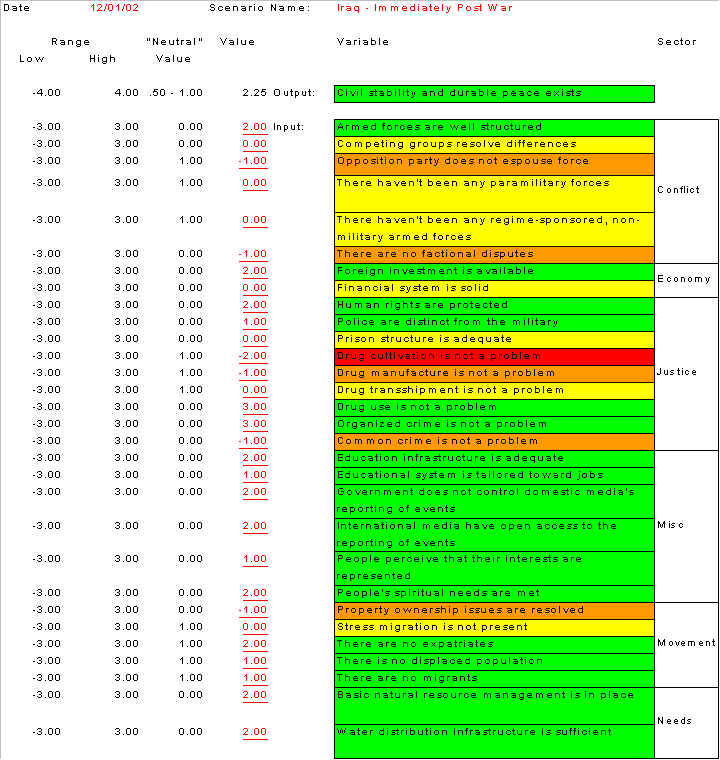 |
The diagram below illustrates the connections among the input variables, and dependent variables, including the output variable. Each sector is given a color to help with identification in the diagram. The conflict sector is colored red; the needs sector is colored green; the movement sector is colored purple; the miscellaneous sector is colored magenta; the justice sector is colored orange; and the economy sector is colored brown. Input variables have the interior of their boxes colored light blue. A seventh sector is comprised of the output variable and the dependent variables that feed directly into it. This is the core sector and it is colored gray.
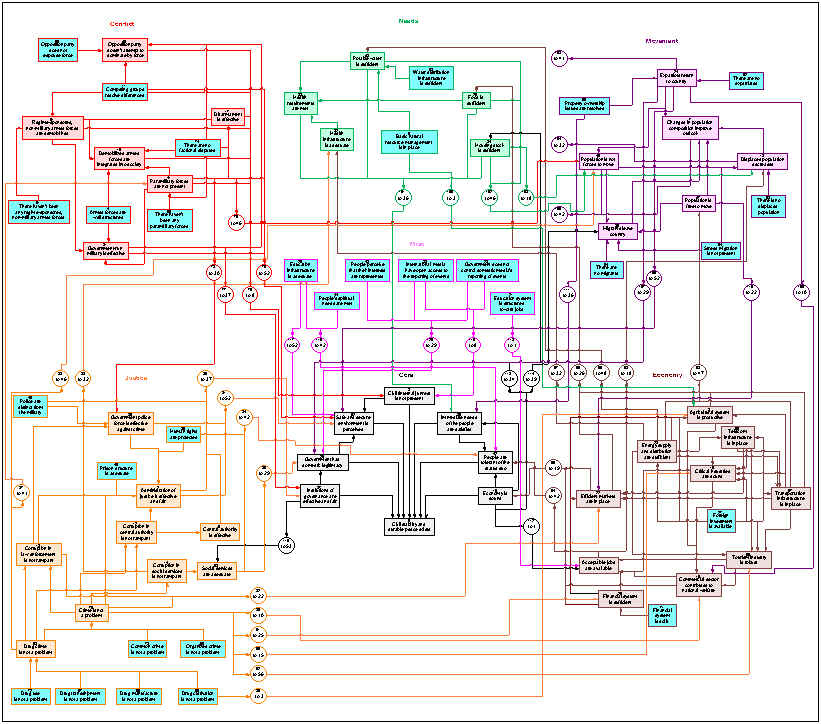 |
ISSM records a graph, such as shown below, to display the changes in stability over time. Seven different graphs are available. The one shown is contains the output variable and the core sector variables. The other six display the output variable and the values for the input variables for each sector. The baloons with event names have been manually added to help visualize the time frame.
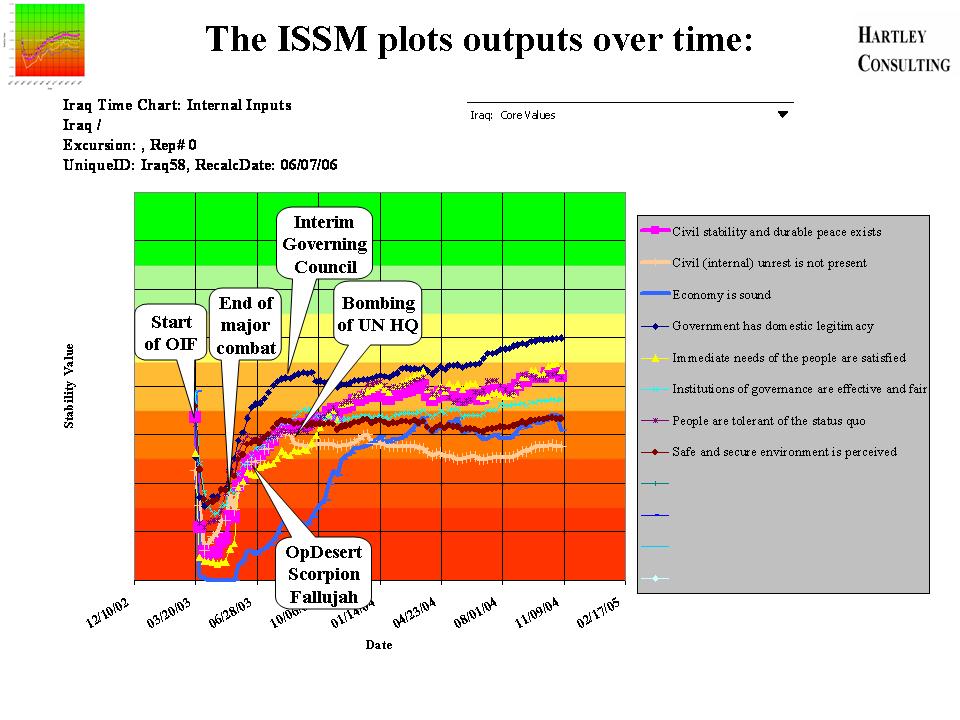 |
The ISSM was added to the Defense Modeling and Simulation Office (DMSO) OOTW toolbox in 2003. It was deployed to Iraq by the Center for Army Analyses (CAA) in the Fall of 2003. The use of the ISSM in an active OOTW has supported its modification and validation.
In 2004, the ISSM was improved to add External Interventions. External interventions are such actions as repairing water and sewage plants, providing medical support and food, and providing security. These additions are shown in the figure below.
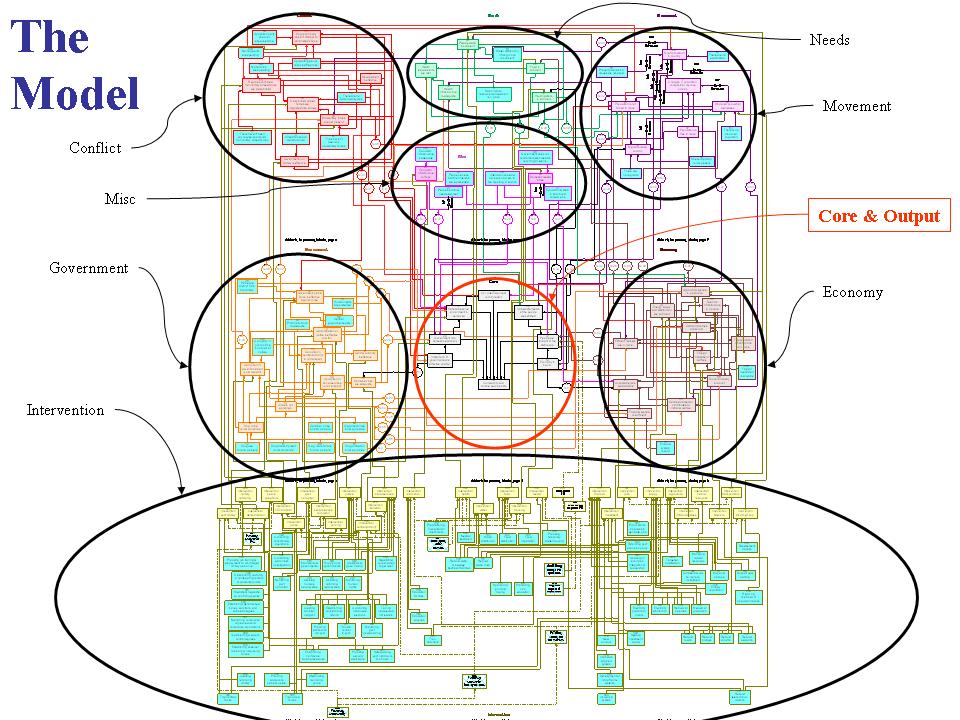 |
In 2005, a Preprocessor, a Postprocessor, and a Controller were added to create the ISSM System, version 3. The Preprocessor allows the user to convert available data into the ISSM inputs through custom logic. The Postprocessor allows the user to create new output variables, based on the intermediate data contained in the ISSM through custom logic. The Controller aids in the configuration management of study files. Additionally, a Users' Guide, an Analysts' Guide, and a Training Package were prepared.
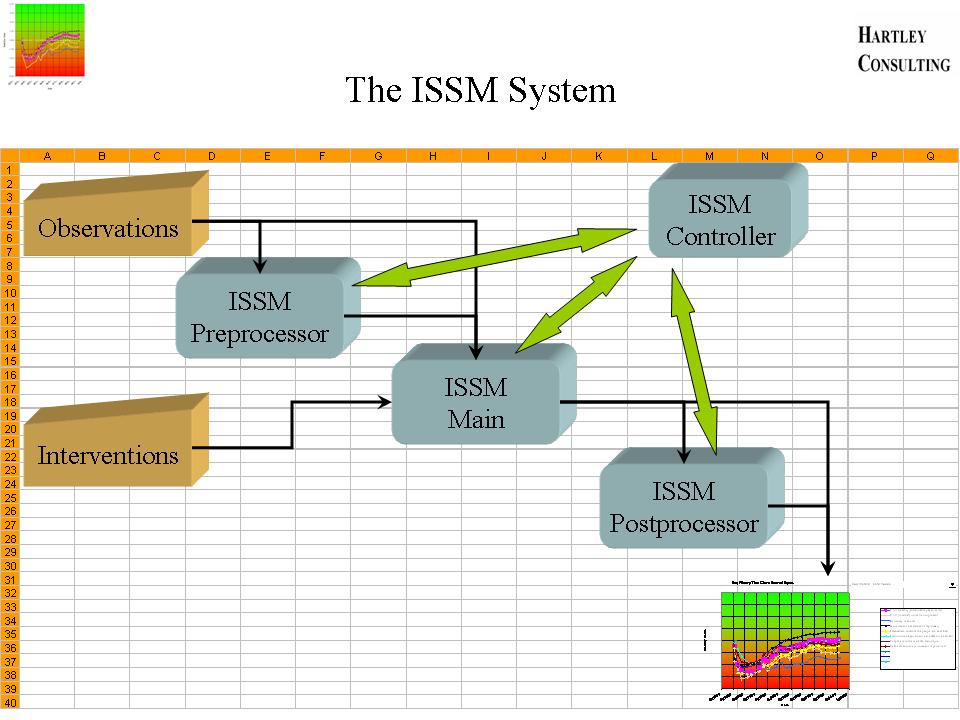 |
Version 3 was used as part of DMSO's FAST OOTW Toolbox to support a Joint Staff/J-8 study in 2005. No single model provides complete coverage of the DIME/PMESII domain. The figure below provides an approximation of the coverage provided by the Toolbox, illustrating that the Toolbox uses synergies to increase the results over those provided by any single model.
|
Each model played its own role in the study. The ISSM's first role was to analyze the pre-scenario run-up, or "road to war," producing the starting conditions for the analysis. During the study, the ISSM used the output of the DIAMOND model as a surogate for reality, producing PMESII analyses during each cycle and producing the majority of the study outputs.
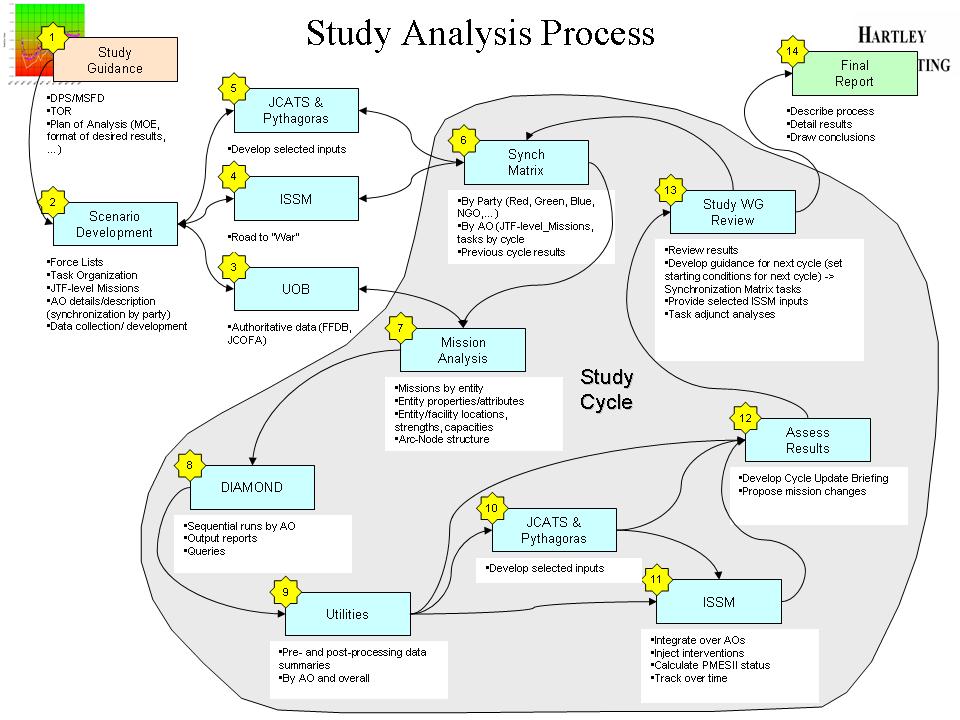 |
In 2006, the ISSM has been further improved. Version 4 adds the capability for automated updates. The ISSM is built as a set of Excel workbooks, which provides accessibility and transparency. However, this implementation has the drawback of requiring an intimate marriage of the model and the data. When a new ISSM model version is created, updating an old model has required a painful, manual transfer of the data in the old version to the new version.
Version 4 provides the means to automatically write out the data from an old model to a file and read the file into the new version. As a byproduct, the process also creates a graphical view of the custom logic of the Preprocessor and the Postprocessor, with thorough checking for completeness and consistency. This supports better verification that the user's desired logic has been properly encoded into the model.
The ISSM was used as a source in creating the DIME/PMESII VV&A Tool and is also being used as a source for an ontology for irregular warfare (TRAC IW Metric Ontology). The results of the ontology project may be used to improve the ISSM.
Hartley Consulting can provide a 5 day training course for the ISSM. This course includes hands-on exercises using the ISSM and culminates with students building scenarios of their own area of interest.
Version 3 is completely documented with a 40+ page Users' Guide and a 140+ page Analysts' Guide. The Users' Guide describes how to use the ISSM System and the Analysts' Guide explains the reasoning behind selecting options.
Documentation for Version 4 includes a 75 page Users' Guide, a 319 page Analysts' Guide, and a 245 page Programmers' Guide.
For specifications of the ISSM, see ISSM Description.
For more on the details of general OOTW tool requirements, see Analytical Tools for OOTW.
For more detail on the DMSO OOTW Toolbox, see OOTW Toolbox.
For more detail on the origins of the modeling behind the ISSM, see: Hayes, Bradd C. and Jeffrey I. Sands. Doing Windows: Non-Traditional Military Responses to Complex Emergencies [external link]. February 1999. PDF version.
If you arrived here using a keyword shortcut, you may use your browser's "back" key to return to the keyword distribution page.
Return to
Hartley's Projects Page